Fostering the Aesthetic Pleasure: The Effect of Verbal Description on Aesthetic Appreciation of Ambiguous and Unambiguous Artworks
Abstract
1. Introduction
2. Materials and Methods
2.1. Participants
2.2. Procedure
2.2.1. Stimuli
2.2.2. Treatment
2.3. Data Analysis
3. Results
4. Discussion
5. Conclusions
Author Contributions
Funding
Institutional Review Board Statement
Informed Consent Statement
Conflicts of Interest
Appendix A
Appendix A.1. Description of “Ambiguous” Portrait “Spring” Created by Arcimboldo, 1573
Appendix A.1.1. Historical Treatment
Appendix A.1.2. Global Treatment
Appendix A.1.3. Local Treatment
Appendix A.2. Description of “Non-Ambiguous” Portrait “Federico da Montefeltro” Created by Piero della Francesca, 1467–1472
Appendix A.2.1. Historical Treatment
Appendix A.2.2. Global Treatment
Appendix A.2.3. Local Treatment
References
- Höfel, L.; Jacobsen, T. Electrophysiological indices of processing aesthetics: Spontaneous or intentional processes? Int. J. Psychophysiol. 2007, 65, 20–31. Available online: https://linkinghub.elsevier.com/retrieve/pii/S0167876007000402 (accessed on 13 October 2021). [CrossRef] [PubMed]
- Nadal, M.; Capó, M.; Munar, E.; Marty, G.; Cela-Conde, C.J. Constraining Hypotheses on the Evolution of Art and Aesthetic Appreciation*. In Neuroaesthetics; Routledge: New York, NY, USA, 2018; pp. 103–129. Available online: https://www.taylorfrancis.com/books/9781351842860/chapters/10.4324/9781315224091-6 (accessed on 11 March 2021).
- Kirk, U.; Skov, M.; Hulme, O.; Christensen, M.S.; Zeki, S. Modulation of aesthetic value by semantic context: An fMRI study. Neuroimage 2009, 44, 1125–1132. [Google Scholar] [CrossRef] [PubMed]
- Wagner, V.; Menninghaus, W.; Hanich, J.; Jacobsen, T. Art schema effects on affective experience: The case of disgusting images. Psychol. Aesthet. Creat. Arts 2014, 8, 120–129. [Google Scholar] [CrossRef]
- Fontoura, P.; Schaeffer, J.-M.; Menu, M. The vision and interpretation of paintings. In Proceedings of the 11th ACM Symposium on Eye Tracking Research & Applications, New York, NY, USA, 25–28 June 2019; pp. 1–3. [Google Scholar] [CrossRef]
- Locher, P.; Overbeeke, K.; Stephan, W. A Framework for Aesthetic Experience. In Proceedings of the CHI 2009 Conference, Boston, MA, USA, 4–9 April 2009; pp. 9–12. Available online: https://www.researchgate.net/profile/Stephan-Wensveen/publication/228485394_A_Framework_for_Aesthetic_Experience/links/00b4951a5e40f31aac000000/A-Framework-for-Aesthetic-Experience.pdf (accessed on 13 October 2021).
- Consoli, G. A Cognitive Theory of the Aesthetic Experience. Contemp. Aesthet. 2012, 10, 1–18. Available online: http://www.contempaesthetics.org/newvolume/pages/article.php?articleID=657 (accessed on 13 October 2021).
- Pelowski, M.; Markey, P.S.; Forster, M.; Gerger, G.; Leder, H. Move me, astonish me… delight my eyes and brain: The Vienna Integrated Model of top-down and bottom-up processes in Art Perception (VIMAP) and corresponding affective, evaluative, and neurophysiological correlates. Phys. Life Rev. 2017, 21, 80–125. [Google Scholar] [CrossRef]
- Nayak, B.K.; Karmakar, S. A Review of Eye Tracking Studies Related to Visual Aesthetic Experience: A Bottom-Up Approach. In Smart Innovation, Systems and Technologies; Springer: Singapore, 2019; pp. 391–403. [Google Scholar] [CrossRef]
- Marković, S. Components of aesthetic experience: Aesthetic fascination, aesthetic appraisal, and aesthetic emotion. i-Perception 2012, 3, 1–17. [Google Scholar] [CrossRef]
- Mamassian, P. Ambiguities and conventions in the perception of visual art. Vis. Res. 2008, 48, 2143–2153. [Google Scholar] [CrossRef]
- Boccia, M.; Nemmi, F.; Guariglia, C. Neuropsychology of environmental navigation in humans: Review and meta-analysis of FMRI studies in healthy participants. Neuropsychol. Rev. 2014, 24, 236–251. [Google Scholar] [CrossRef]
- Boccia, M.; Nemmi, F.; Tizzani, E.; Guariglia, C.; Ferlazzo, F.; Galati, G.; Giannini, A.M. Do you like Arcimboldo’s? Esthetic appreciation modulates brain activity in solving perceptual ambiguity. Behav. Brain Res. 2015, 278, 147–154. [Google Scholar] [CrossRef]
- Chatterjee, A. The neuropsychology of visual artistic production. Neuropsychol. 2004, 42, 1568–1583. [Google Scholar] [CrossRef]
- Cela-Conde, C.J.; Agnati, L.; Huston, J.P.; Mora, F.; Nadal, M. The neural foundations of aesthetic appreciation. Prog. Neurobiol. 2011, 94, 39–48. [Google Scholar] [CrossRef] [PubMed]
- Cupchik, G.C.; Vartanian, O.; Crawley, A.; Mikulis, D.J. Viewing artworks: Contributions of cognitive control and perceptual facilitation to aesthetic experience. Brain Cogn. 2009, 70, 84–91. [Google Scholar] [CrossRef]
- Zeki, S. The neurology of ambiguity. Conscious. Cogn. 2004, 13, 173–196. [Google Scholar] [CrossRef]
- Yevin, I. Ambiguity in art. Complexus 2006, 3, 74–82. [Google Scholar] [CrossRef]
- Jakesch, M.; Leder, H.; Forster, M. Image ambiguity and fluency. PLoS ONE 2013, 8, e74084. [Google Scholar] [CrossRef]
- Jakesch, M.; Leder, H. Finding meaning in art: Preferred levels of ambiguity in art appreciation. Q. J. Exp. Psychol. 2009, 62, 2105–2112. [Google Scholar] [CrossRef]
- Muth, C.; Hesslinger, V.M.; Carbon, C.-C. The appeal of challenge in the perception of art: How ambiguity, solvability of ambiguity, and the opportunity for insight affect appreciation. Psychol. Aesthet. Creat. Arts 2015, 9, 206–216. [Google Scholar] [CrossRef]
- Zeki, S. Splendours and miseries of the brain. Philos. Trans. R. Soc. Lond. Ser. B Biol. Sci. 1999, 354, 2053–2065. [Google Scholar] [CrossRef][Green Version]
- Navon, D. Forest before trees: The precedence of global features in visual perception. Cogn. Psychol. 1977, 9, 353–383. [Google Scholar] [CrossRef]
- Milne, E.; Szczerbinski, M. Global and local perceptual style, field-independence, and central coherence: An attempt at concept validation. Adv. Cogn. Psychol. 2009, 5, 1. [Google Scholar] [CrossRef] [PubMed][Green Version]
- Solé Puig, M.; Puigcerver, L.; Aznar-Casanova, J.A.; Supèr, H. Difference in visual processing assessed by eye vergence movements. PLoS ONE 2013, 8, e72041. [Google Scholar] [CrossRef] [PubMed]
- Staudinger, M.R.; Fink, G.R.; Mackay, C.E.; Lux, S. Gestalt perception and the decline of global precedence in older subjects. Cortex 2011, 47, 854–862. [Google Scholar] [CrossRef]
- Boccia, M.; Barbetti, S.; Margiotta, R.; Guariglia, C.; Ferlazzo, F.; Giannini, A.M. Why do you like Arcimboldo’s portraits? Effect of perceptual style on aesthetic appreciation of ambiguous artworks. Atten. Percept. Psychophys. 2014, 76, 1516–1521. [Google Scholar] [CrossRef]
- Boccia, M.; Guariglia, P.; Piccardi, L.; De Martino, G.; Giannini, A.M. The detail is more pleasant than the whole: Global and local prime affect esthetic appreciation of artworks showing whole-part ambiguity. Atten. Percept. Psychophys. 2020, 82, 3266–3372. [Google Scholar] [CrossRef] [PubMed]
- Russell, P.A. Effort after meaning and the hedonic value of paintings. Br. J. Psychol. 2003, 94, 99–110. [Google Scholar] [CrossRef]
- Leder, H.; Carbon, C.-C.; Ripsas, A.-L. Entitling art: Influence of title information on understanding and appreciation of paintings. Acta Psychol. 2006, 121, 176–198. [Google Scholar] [CrossRef] [PubMed]
- Millis, K. Making meaning brings pleasure: The influence of titles on aesthetic experiences. Emotion 2001, 1, 320. [Google Scholar] [CrossRef]
- Kapoula, Z.; Daunys, G.; Herbez, O.; Yang, Q. Effect of Title on Eye-Movement Exploration of Cubist Paintings by Fernand Léger. Perception 2009, 38, 479–491. [Google Scholar] [CrossRef]
- Gerger, G.; Leder, H. Titles change the esthetic appreciations of paintings. Front. Hum. Neurosci. 2015, 9, 1–10. Available online: http://journal.frontiersin.org/Article/10.3389/fnhum.2015.00464/abstract (accessed on 13 October 2021). [CrossRef] [PubMed]
- Berlyne, D.E. Aesthetics and Psychobiology; Appleton-Century-Crofts: New York, NY, USA, 1971. [Google Scholar]
- Berlyne, D.E. Studies in the New Experimental Aesthetics: Steps toward an Objective Psychology of Aesthetic Appreciation; Hemisphere: Washington, DC, USA, 1974. [Google Scholar]
- Klimek, L.; Bergmann, K.-C.; Biedermann, T.; Bousquet, J.; Hellings, P.; Jung, K.; Merk, H.; Olze, H.; Schlenter, W.; Stock, P.; et al. Visual analogue scales (VAS): Measuring instruments for the documentation of symptoms and therapy monitoring in cases of allergic rhinitis in everyday health care. Allergo J. Int. 2017, 26, 16–24. Available online: http://link.springer.com/10.1007/s40629-016-0006-7 (accessed on 13 October 2021). [CrossRef]
- Mathôt, S.; Schreij, D.; Theeuwes, J. OpenSesame: An open-source, graphical experiment builder for the social sciences. Behav. Res. Methods. 2012, 44, 314–324. [Google Scholar] [CrossRef] [PubMed]
- Boccia, M.; Barbetti, S.; Piccardi, L.; Guariglia, C.; Giannini, A.M. Neuropsychology of aesthetic judgment of ambiguous and non-ambiguous artworks. Behav. Sci. 2017, 7, 13. [Google Scholar] [CrossRef]
- Bartlett, F.C. Remembering; Cambridge University Press: Cambridge, UK, 1932. [Google Scholar]
- Belke, B.; Leder, H.; Augustin, D. Mastering style. Effects of explicit style-related information, art knowledge and affective state on appreciation of abstract paintings. Psychol. Sci. 2006, 48, 115. [Google Scholar]
- Kawabata, H.; Zeki, S. Neural correlates of beauty. J. Neurophysiol. 2004, 91, 1699–1705. [Google Scholar] [CrossRef]
- Scherer, K.R. What are emotions? And how can they be measured? Soc. Sci. Inf. 2005, 44, 695–729. [Google Scholar] [CrossRef]
- Temme, J.E.V. Amount and kind of information in museums: Its effects on visitors satisfaction and appreciation of art. Vis. Arts Res. 1992, 18, 28–36. [Google Scholar]
- Swami, V. Context matters: Investigating the impact of contextual information on aesthetic appreciation of paintings by Max Ernst and Pablo Picasso. Psychol. Aesthet. Creat. Arts. 2013, 7, 285. [Google Scholar] [CrossRef]
- Stojilović, I.Z.; Marković, S. Evaluation of paintings: Effects of lectures. Psihologija 2014, 47, 415–432. [Google Scholar] [CrossRef]
- Leder, H.; Belke, B.; Oeberst, A.; Augustin, D. A model of aesthetic appreciation and aesthetic judgments. Br. J. Psychol. 2004, 95, 489–508. [Google Scholar] [CrossRef] [PubMed]
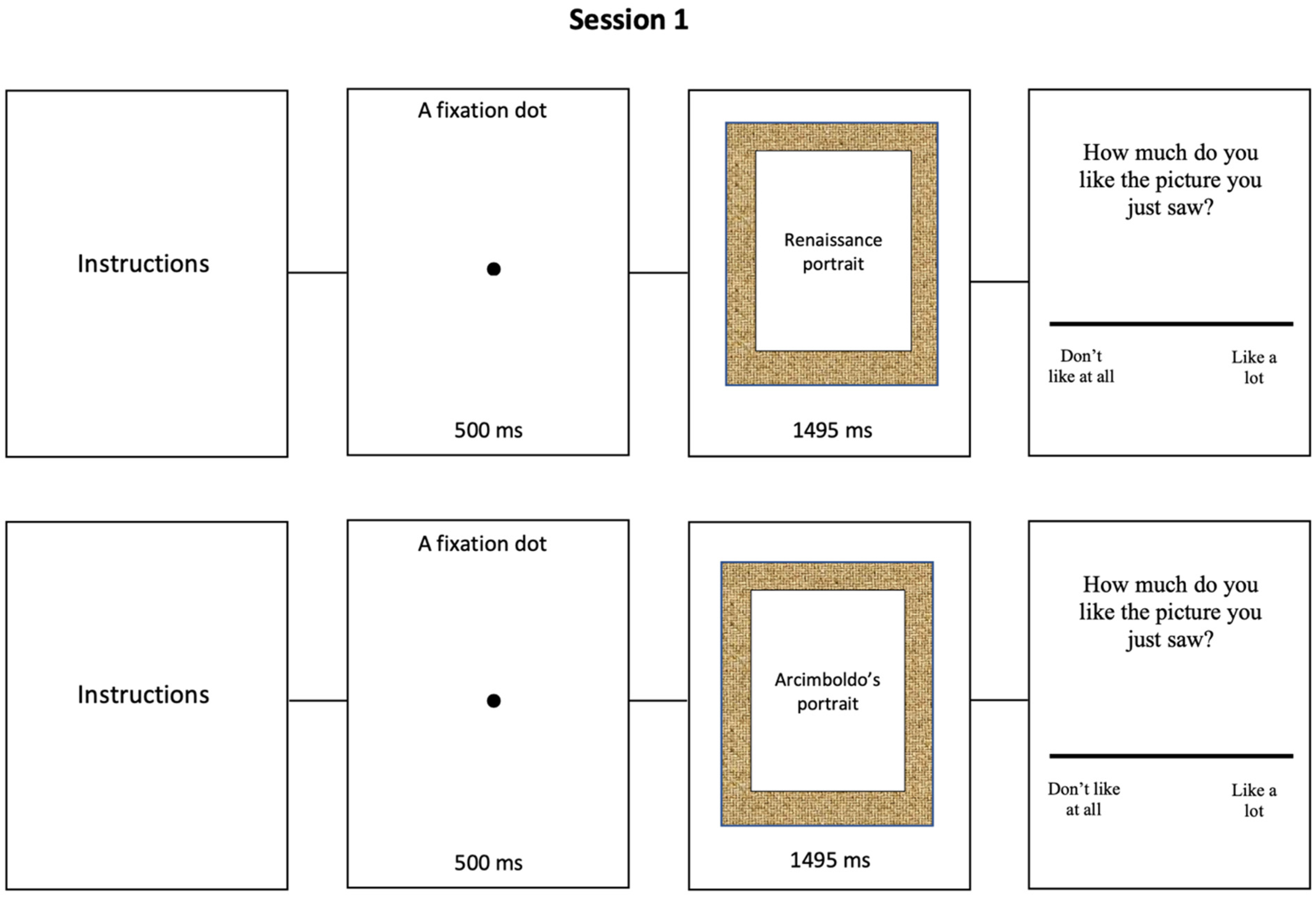
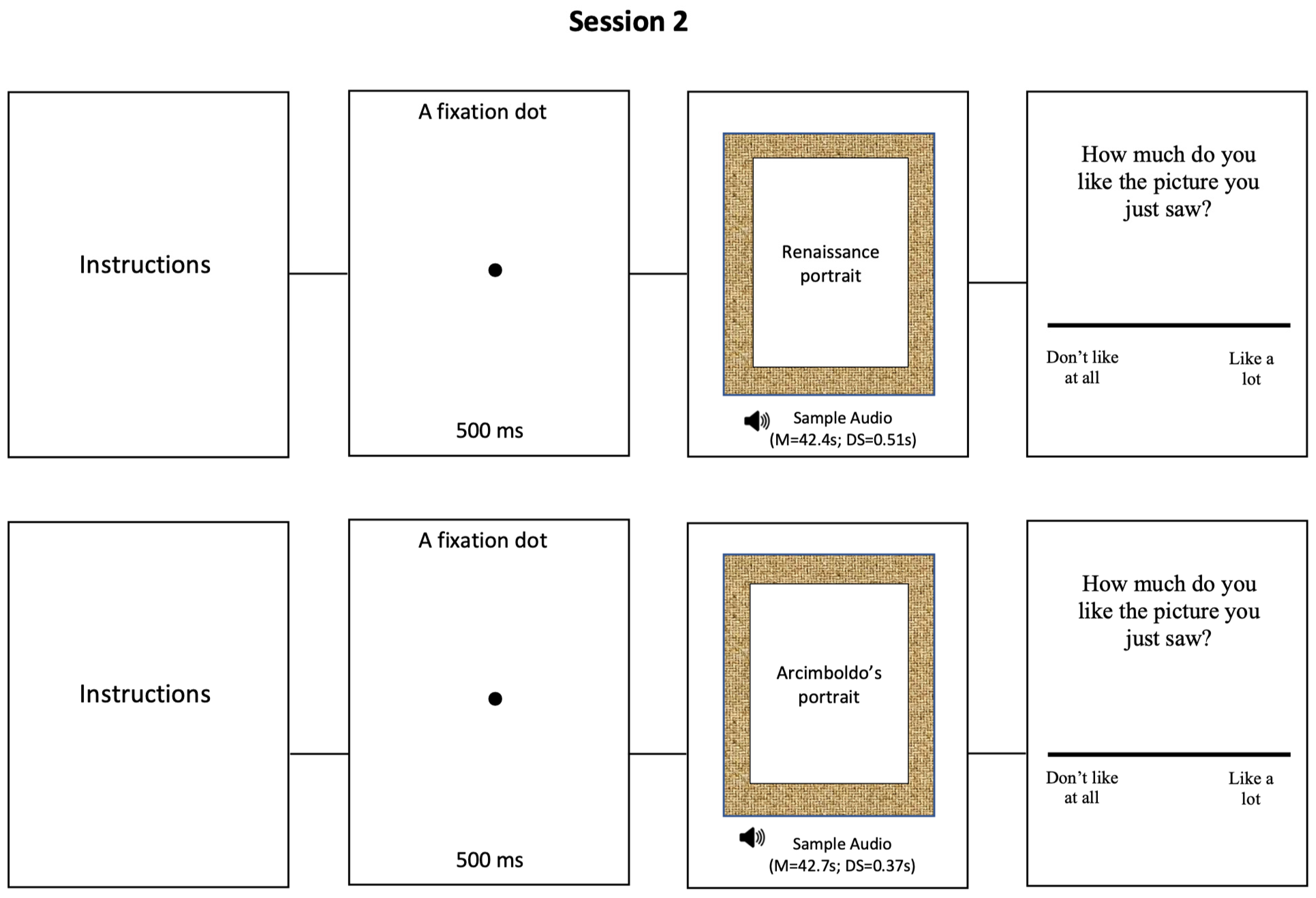
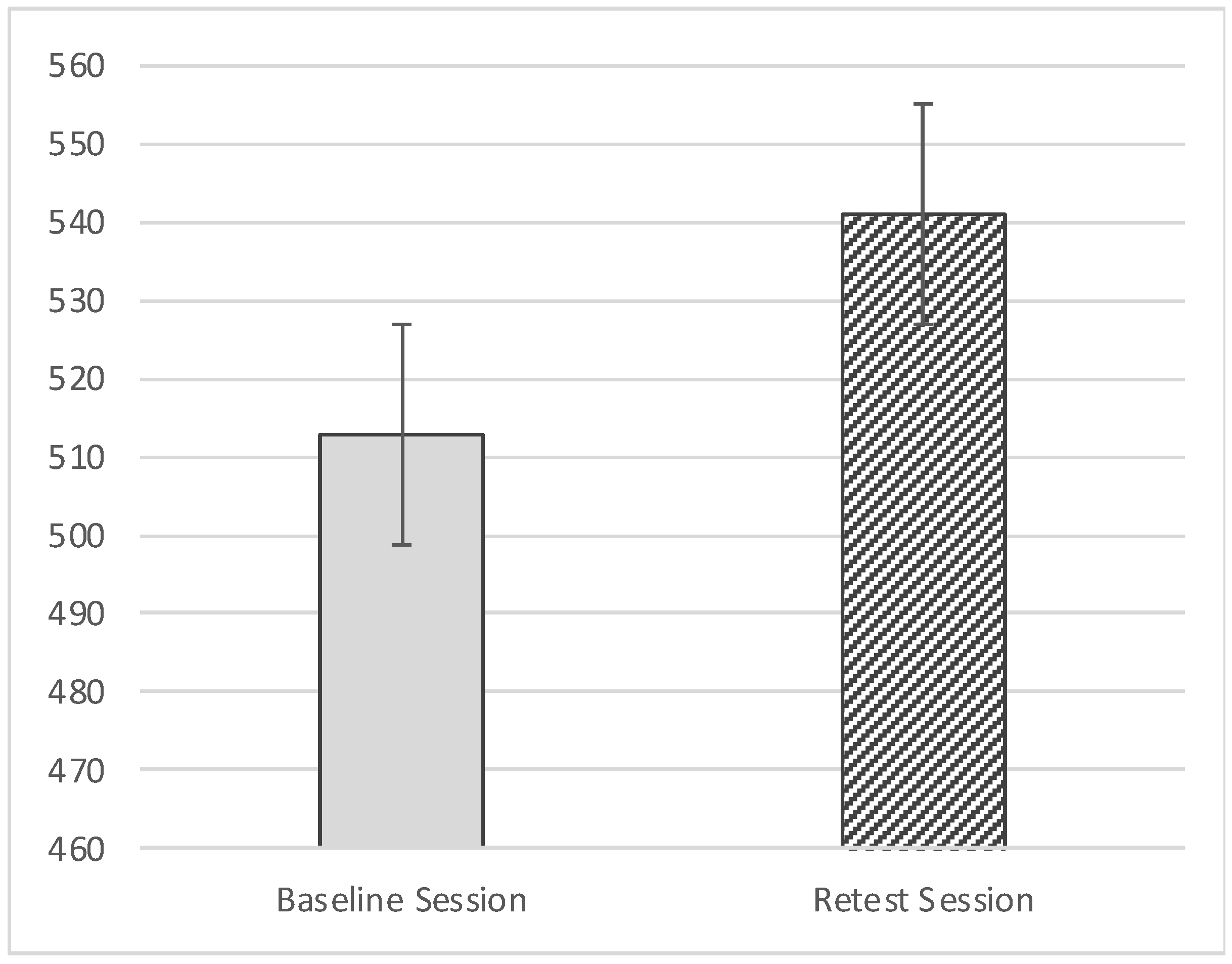
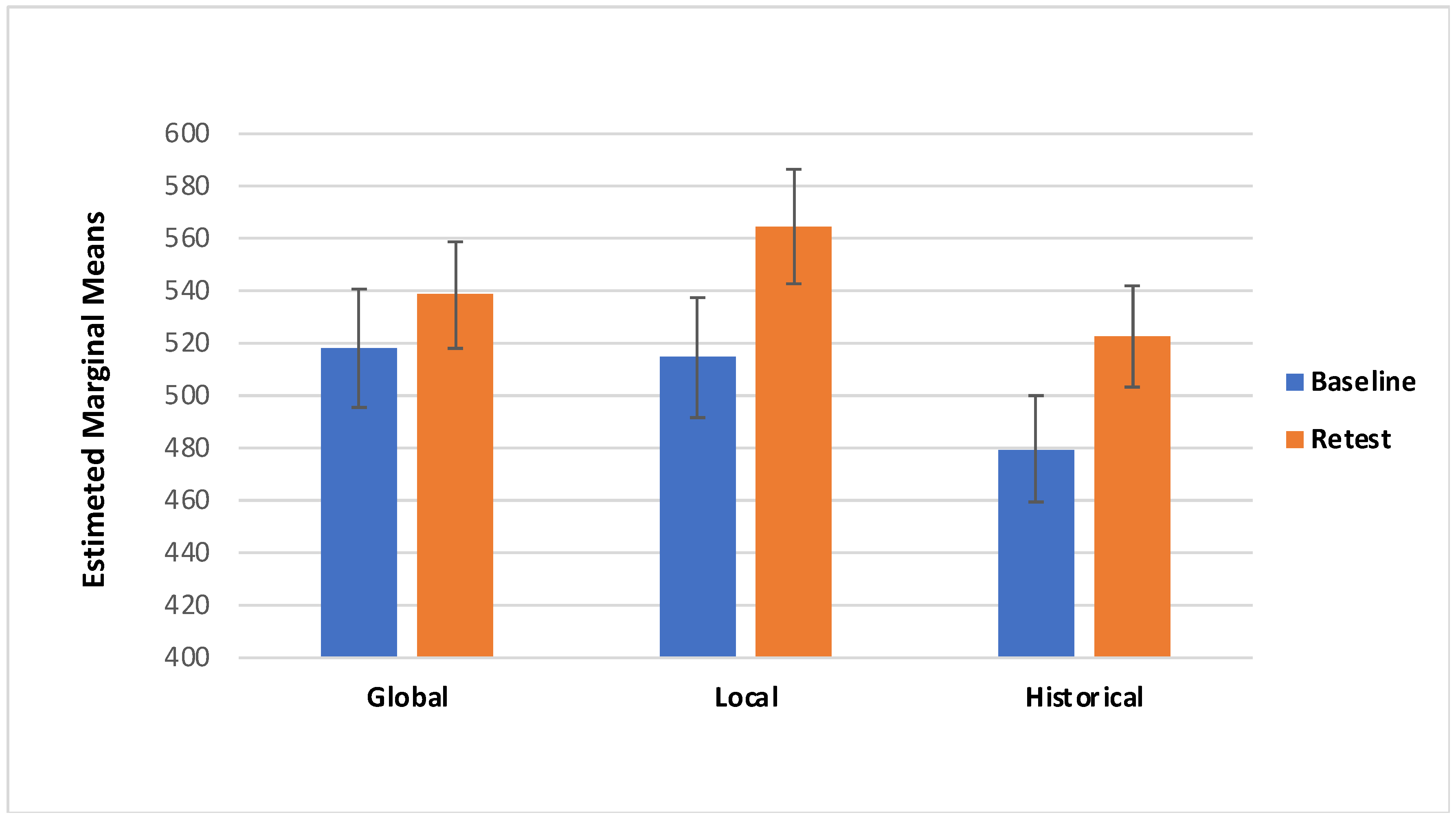
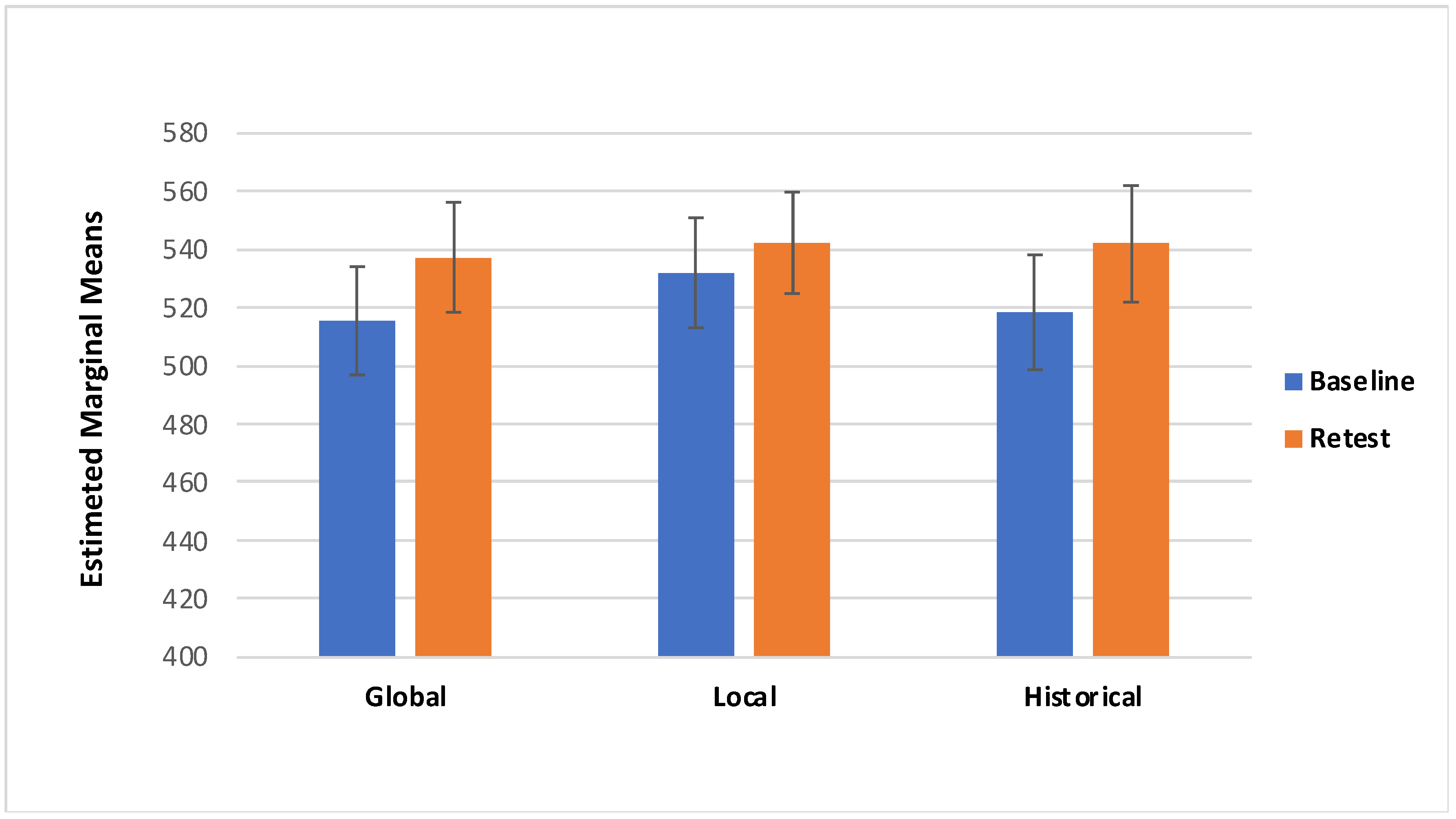
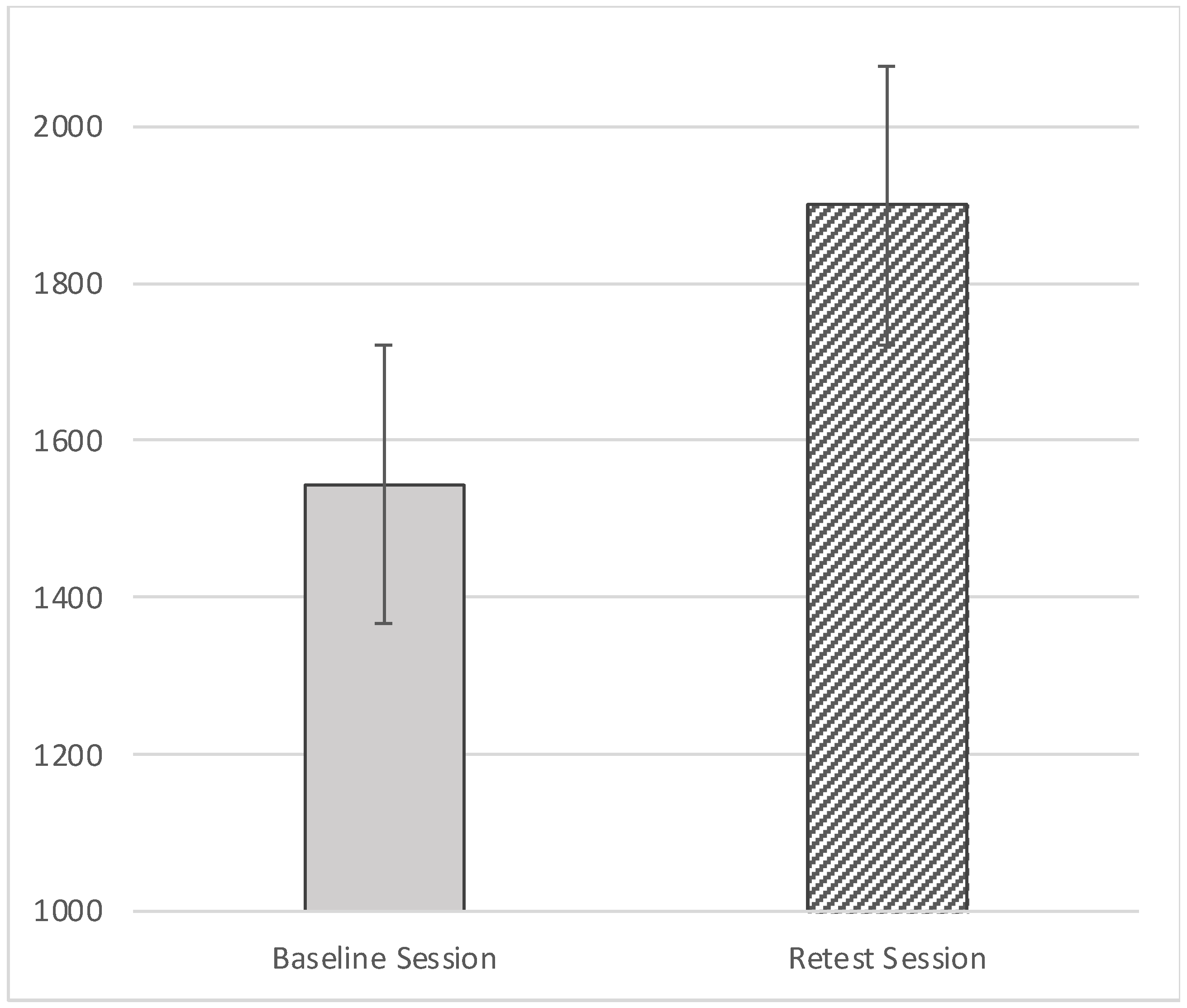

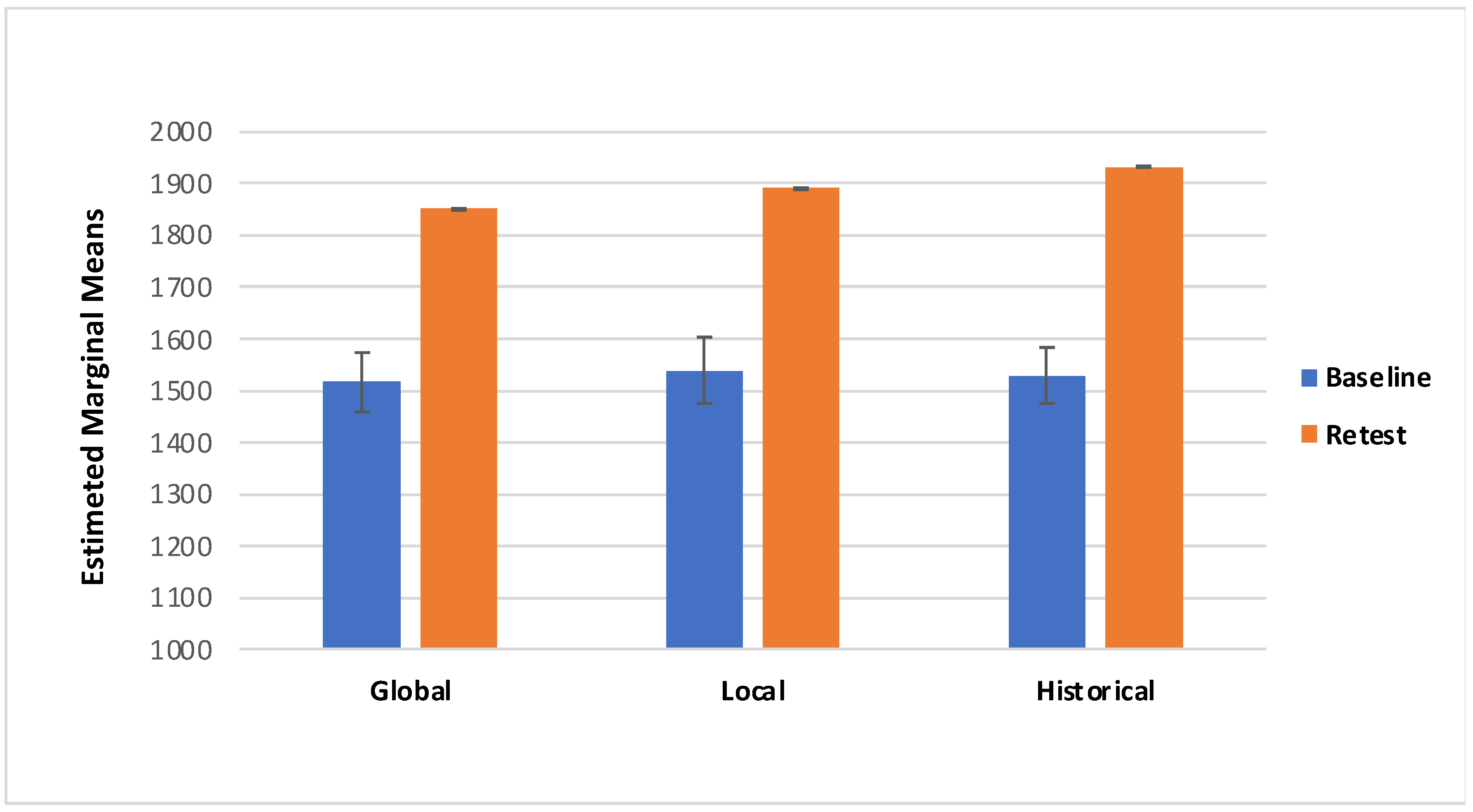
| Pairwise Comparisons Session * Category * Treatment | ||||||
|---|---|---|---|---|---|---|
| Category | Treatment | Session | Mean Difference | Std. Error | Sig. b | |
| Ambiguous | Global | 2 | 1 | 20.355 | 13.277 | 0.129 |
| Local | 2 | 1 | 49.759 | 15.273 | 0.002 | |
| Historical | 2 | 1 | 42.964 | 14.184 | 0.003 | |
| Renaissance | Global | 2 | 1 | 21.771 | 8.912 | 0.017 |
| Local | 2 | 1 | 10.300 | 11.245 | 0.362 | |
| Historical | 2 | 1 | 23.440 | 9.470 | 0.015 | |
Publisher’s Note: MDPI stays neutral with regard to jurisdictional claims in published maps and institutional affiliations. |
© 2021 by the authors. Licensee MDPI, Basel, Switzerland. This article is an open access article distributed under the terms and conditions of the Creative Commons Attribution (CC BY) license (https://creativecommons.org/licenses/by/4.0/).
Share and Cite
Mari, E.; Quaglieri, A.; Lausi, G.; Boccia, M.; Pizzo, A.; Baldi, M.; Barchielli, B.; Burrai, J.; Piccardi, L.; Giannini, A.M. Fostering the Aesthetic Pleasure: The Effect of Verbal Description on Aesthetic Appreciation of Ambiguous and Unambiguous Artworks. Behav. Sci. 2021, 11, 144. https://doi.org/10.3390/bs11110144
Mari E, Quaglieri A, Lausi G, Boccia M, Pizzo A, Baldi M, Barchielli B, Burrai J, Piccardi L, Giannini AM. Fostering the Aesthetic Pleasure: The Effect of Verbal Description on Aesthetic Appreciation of Ambiguous and Unambiguous Artworks. Behavioral Sciences. 2021; 11(11):144. https://doi.org/10.3390/bs11110144
Chicago/Turabian StyleMari, Emanuela, Alessandro Quaglieri, Giulia Lausi, Maddalena Boccia, Alessandra Pizzo, Michela Baldi, Benedetta Barchielli, Jessica Burrai, Laura Piccardi, and Anna Maria Giannini. 2021. "Fostering the Aesthetic Pleasure: The Effect of Verbal Description on Aesthetic Appreciation of Ambiguous and Unambiguous Artworks" Behavioral Sciences 11, no. 11: 144. https://doi.org/10.3390/bs11110144
APA StyleMari, E., Quaglieri, A., Lausi, G., Boccia, M., Pizzo, A., Baldi, M., Barchielli, B., Burrai, J., Piccardi, L., & Giannini, A. M. (2021). Fostering the Aesthetic Pleasure: The Effect of Verbal Description on Aesthetic Appreciation of Ambiguous and Unambiguous Artworks. Behavioral Sciences, 11(11), 144. https://doi.org/10.3390/bs11110144













